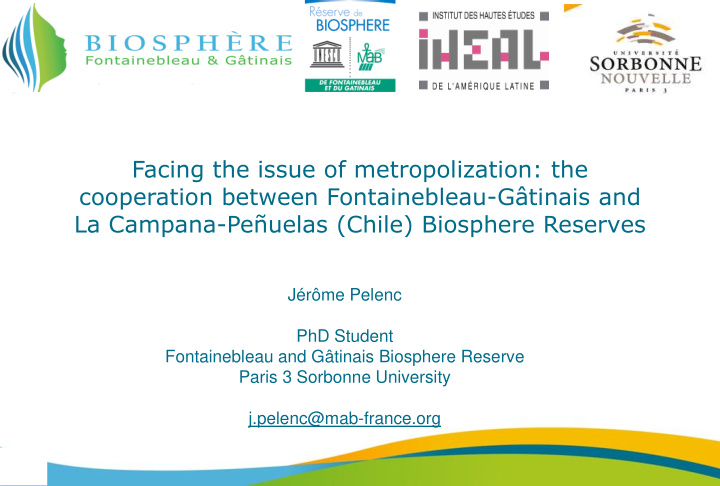



Facing the issue of metropolization: the cooperation between Fontainebleau-Gâtinais and La Campana-Peñuelas (Chile) Biosphere Reserves Jérôme Pelenc PhD Student Fontainebleau and Gâtinais Biosphere Reserve Paris 3 Sorbonne University j.pelenc@mab-france.org
Structure 1. Main characteristics of metropolitan regions 2. Challenges for Fontainebleau/Gâtinais and La Campana-Penuelas Biosphere Reserves 3. Cooperation between the two biosphere reserves to meet the challenge of Sustainable Development
I Main characteristics of metropolitan regions
Metropolization: a global phenomenon Some features existing both in Northern and Southern countries : • Concentration of the population, economic activities and decision making power in open urban areas whith unceasing mobilities • Accelerated land-use changes, urban sprawl, less clearly defined urban/rural boundaries • Classification of social groups within increasingly fragmented spaces … Metropolitan Regions are suffering the strongest environmental pressures and are also places where the issue of sustainability affects the greatest number of people
The Fontainebeau/Gâtinais and La Campana- Peñuelas Biosphere Reserves (BR) metropolitan context
Fontainebleau et du Gâtinais BR La Campana-Peñuelas BR • 60 km from Santiago and contiguous to Valparaiso • 60 km from Paris • 124 083 inhabitants on 238 216 ha • 267 655 inhabitants on 150 544 ha • Macro Region of Santiago-Valparaiso : • Region IDF 12 millions inhabitants 8,5 millions inhabitants = half of the national 20% of the national population on 2% population of the French territory Private property lands (except core areas) Very large number of stakeholders
Melun Valparaiso Paris Santiago
Question Are Biosphere Reserves relevant tools for metropolization management?
II Challenges for Fontainebleau/Gâtinais and La Campana-Penuelas Biosphere Reserves
1. Territorial consistency • Taking into account the various metropolitan spaces (from big cities to natural protected areas) in order to coordinate the construction of whole territorial consistency 2. Connection between local and global levels • Sustainable encounter of the various stakeholders representing the different scales and territories
3. Governance • Implementing a politically neutral platform to discuss and negotiate agreements between cities and their hinterlands about a shared vision of sustainability 4. Promotion of change • Innovating, supporting et coordinating innovative actors in order to use the dynamics of metropolization as a vector of sustainable development
III The cooperation between the two Biosphere Reserves to meet the challenge of Sustainable Development
Cooperation agreement Important points: • Acknowledge the shared caracteristics of both BR • A common will to develop an appropriate management in this special context • Themes of mutual interest • Exchange procedures • Signed for three years (2009-2012), renewable, one coordinator per BR
Working plan • Co-developed with our Chilean partners • 3 years = 3 steps : -1 st year: learning about each other -2 nd year: building together and meeting each other -3 rd year: self-assessment and planning for the future
Priorities • Metropolization management • Peri-urban ecotourism • Communication and citizens participation • Charter for products, services and events of the BR territory Structure the information exchange, the technical visit and joint productions
Some examples of activities: • Preparation of a document presenting each BR • Construction of a shared language (3 parts; administrative, ecological, socio-economic) • Organization of a technical visit
Mutual benefits of the cooperation • Each BR could learn from each other’s experiences and try to adapt the outcomes to its own context • Building a common experience to face the shared issues Mutualizing experiences and skills to meet the challenge of a sustainable development construction
Conclusion • The comparison and cooperation between the two BR offer a unique opportunity to develop a true reflection on the role and functionning of BR in metropolitan context. That is very important because metropolitan • regions are places where pressure on the biophysical environment is the strongest and where the issue of sustainability affects the greatest number of people.
Thank you very much for your attention
Recommend
More recommend